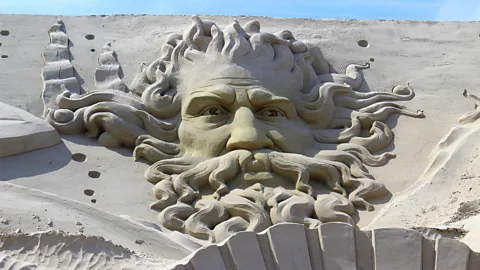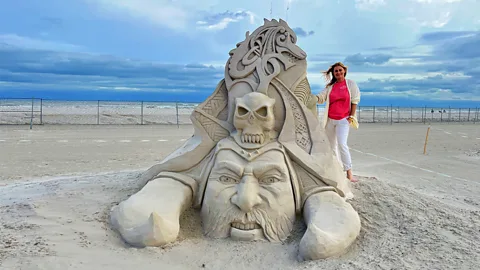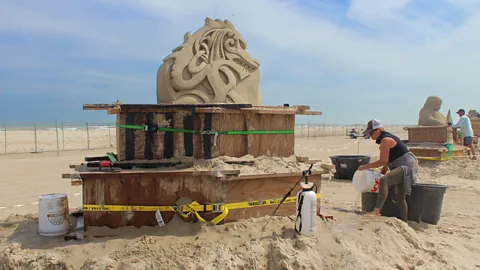The triumphant return of the US' sandcastle championships
 David Perry
David PerryLocated on a barrier island just off Texas' city of Corpus Christi, Port Aransas (population: 3,600) is barely more than a sleepy hamlet most of the year. However, for three days each April (19-21 April 2024), tens of thousands of people descend on this classic Texan beach town from all over the world when it becomes the epicentre of the sand-sculpting universe.
The largest "native sand" sand-sculpting competition in the world – using sand that is on site, rather than carted in – Texas SandFest began in the mid-1990s when two local women began creating sand art on the beach. Word spread, and in 1997, Port Aransas decided to make the artwork the star of a new beach festival. It started off as a small and local celebration. But as the saying prophetically goes, "Everything is bigger in Texas".
"Our first festival was maybe 800 people, across 200ft," recalls site manager Dave Gizicki, who is responsible for making sure everyone and everything has its allotted space on the beach. "SandFest now takes up 2,000ft, and from the ticket sales, we expect 30,000 visitors a day."
This year represents an artistic return. Sculptor coordinator Suzanne Altamare tells how the festival inadvertently fell afoul of Texas' controversial pandemic policies. Despite watchcries from medical professionals, the state reopened in 2021 even as Covid cases continued to rise. SandFest organisers likewise pushed for the festival to commence, even with the restriction of limiting outdoor events to 100 people. The artists that did attend used their sculptures for thinly veiled political statements; one sculptor had Abraham Lincoln facepalming.
"And I hate political statements," Altamare says. "It's not what SandFest is about."
 David Perry
David PerryWith restrictions now lifted, SandFest 2024 has banned all polemics, realigning the festivities to what they were in 1997: fun.
Competing for the $2,000 grand prize are 28 pro-level sculptors from the US, Canada and even Bulgaria. While there is no official "circuit" of sand-sculpting competitions, a SandFest win is highly prestigious. Many of the SandFest pros, who attend by invite only, are trained industrial designers, while others have decades of sand-sculpting under their belts.
Provided the subject matter is G-rated, artists can sculpt whatever the sand can hold – and the more ambitious, the better. Craftmanship and stylistic consistency count, but sculptor Amanda Bolduc and other artists tell me their work is judged by one question alone: "How did they do that?"
"You can evoke so much emotion out of people," says Bolduc, who created a Viking-Celtic sage topped by a dragon this year. "You can get them crying, get them laughing, you can do all these things with the art you create," she adds. "People are astounded at what you can do with sand."
 David Perry
David PerryAnd it all boils down to the type of sand. Powdery white-sand beaches often have sand grains so round and fine they cannot hold a sculpted shape. Other beaches, particularly those in the Mediterranean, are far too gravelly. Bolduc praises Port Aransas as one of the best beaches in the world for sand-sculpting: the grains are small enough to mould but are jagged enough that they lock together, adding structural strength to the sculpture and allowing fine detail. The sand is the reason SandFest is held in such high regard.
More like this:
- The travelling grandma who forever changed the US
- Why is Florida 'breaking up' with spring break?
- The surprising US region that'shome to the world's oldest forests
But artistic know-how helps, too. Bolduc storyboards a potential work months before she hits the beach, going so far as to make a miniature clay model she takes with her to competitions. Competitors can also build wooden frames to support their piece from within. The next step is to glue the sculptures into place.
"That's where I come in," says Irene Gizicki. While her husband Dave makes sure artists keep to their assigned plots, Irene and her crew make the rounds among the sculptures, periodically spraying biodegradable glue on the artwork to prevent wind from blowing details away.
"Wind is the enemy," she says, describing how even a minor breeze can set artists back hours. "But I also make sure artists all have water and their tools. And drinks! Once they start sculpting, they can't stop; there's a timer, after all."
 David Perry
David PerryThe competitors start a day before the festival opens for "pound-up", when they set the frames used to hold the sculptures, filling and tamping them with 20,000 pounds of wet sand. This sets overnight and sculpting begins the following morning. From there, competitors get seven hours a day until the final day of the competition (21 April 2024), when the tools go down at 13:00 and judging commences.
Other Port Aransas experiences:
This year's winner was "Sweet Dreams Are Made Of These", a gothic scene of a dozing woman envisioning a vampire. Created by Canadian Abe Waterman, it was his use of detail and foreshortening that won over the panel of judges: looming up behind the prone dreamer, the vampire's arms reach around and outward. And by making the vampire's hands huge compared to his head, Waterman's creation seems to jump out of the sculpture and snatch at the onlookers.
"I started with a shape that turned into a vampire," Waterman says, whose admittedly fluid conceptualisation of a piece – practically done on-site – is in stark contrast to Bolduc and other sculptors who meticulously plan their pieces beforehand.
 David Perry
David PerryAlas, sand sculptures are as ephemeral as the dunes. After the awards are given and prizes announced, the bulldozers come in for "the crush". The beach is flattened, with wind and tide smoothing the shoreline, readying Port Aransas as Corpus Christi's go-to spot for summer.
"They get so creative," said one tarrying onlooker. Was she getting inspiration? If so, then the artists did their job, and, as Altamare tells me, are already planning for 2025.
"It's only sand," she says, "but you can do so many things with it."
--
For the best of BBC.com in your inbox every Friday, sign up to The Essential List newsletter for a handpicked selection of features, videos and can't-miss news.
